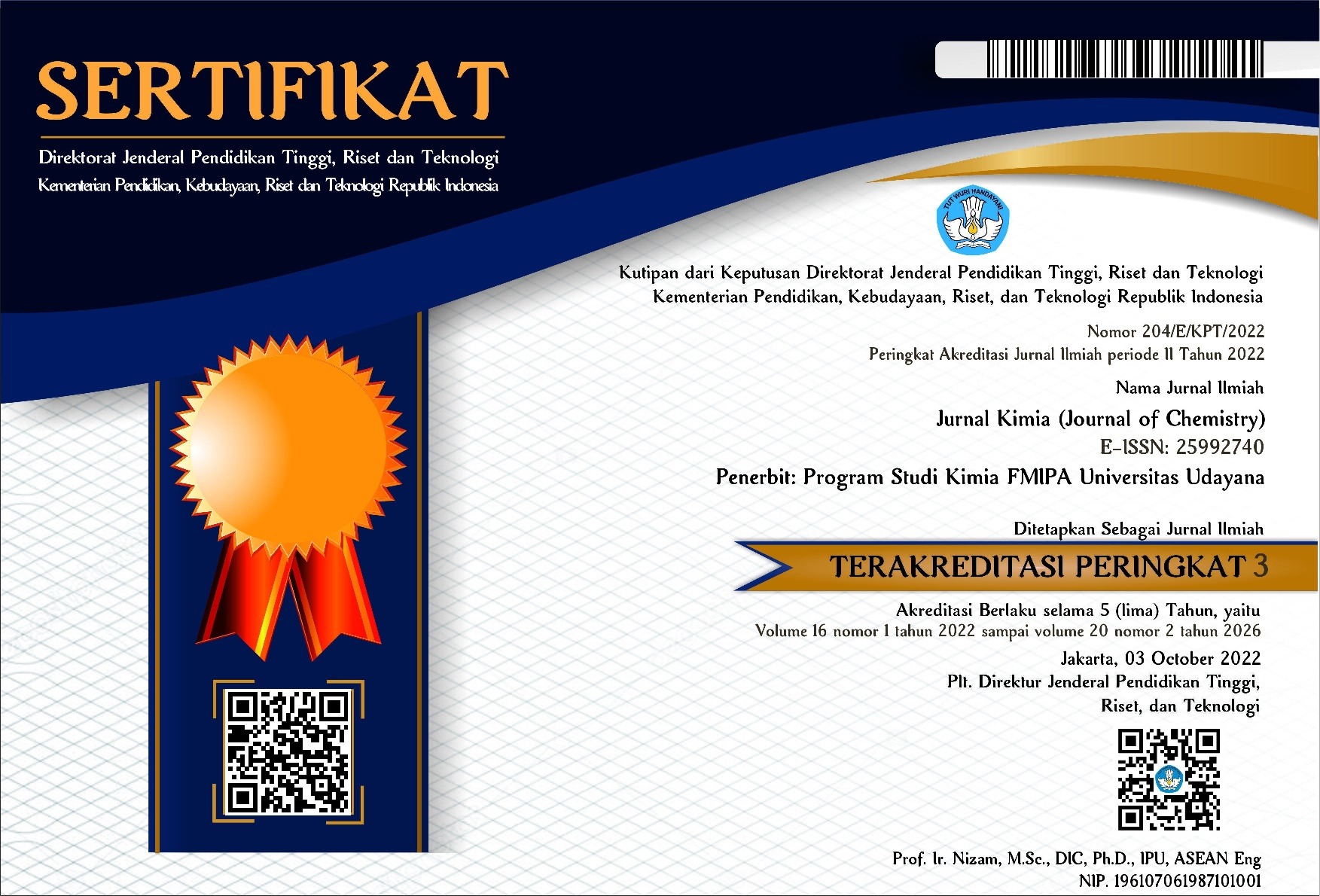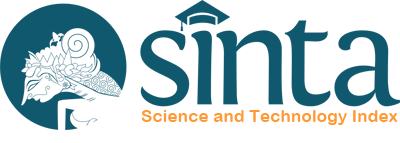PEMANFAATAN AMPAS KOPI TERAKTIVASI H3PO4 SEBAGAI BIOSORBEN ZAT WARNA REMAZOL YELLOW FG
Abstract
Ampas kopi merupakan salah satu limbah yang dapat dimanfaatkan sebagai biosorben. Biosorben ampas kopi ini dapat digunakan untuk menurunkan kandungan zat warna pada limbah tekstil seperti Remazol Yellow FG. Tujuan dari penelitian ini adalah menentukan konsentrasi optimum aktivator H3PO4, kondisi optimum dan kapasitas adsorpsi biosorben ampas kopi. Preparasi biosorben ampas kopi melalui tahap pencucian, pengeringan, pengayakan dan aktivasi dengan penambahan H3PO4 berbagai konsentrasi. Karakterisasi ampas kopi meliputi luas permukaan yang dianalisis menggunakan metilen biru, keasaman permukaan, dan identifikasi gugus fungsi dengan Fourier Transform Infrared (FTIR) Shimadzu/IR Prestige 21. Hasil aktivasi biosorben terbaik diperoleh pada konsentrasi H3PO4 sebesar 0,3 M (KAH). Kondisi optimum adsorpsi zat warna Remazol Yellow FG yakni pada waktu kontak 60 menit dan pH 2. Kapasitas adsorpsi biosorben yang diperoleh sebesar 30,2115 mg/g. Model isoterm yang terbaik yakni isoterm adsorpsi Langmuir dengan R2 sebesar 0,9851
Kata kunci: adsorpsi Langmuir, ampas kopi, biosorben, limbah tekstil, Remazol Yellow FG
ABSTRACT
Coffee residue is a waste that can be used as a biosorbent to reduce the concentration of dye agents in textile waste, such as Remazol Yellow FG. This research aimed to determine the optimum concentration of H3PO4 as an activator, the optimum adsorption conditions, and the adsorption capacity of the coffee residue biosorbent. The preparation of the biosorbent was conducted by washing, drying, sieving, and activating with the addition of H3PO4 solutions at various concentrations. The biosorbent was characterized for its surface area using the methylene blue method, surface acidity, and functional group contents using Fourier Transform Infrared (FTIR) Shimadzu/IR Prestige 21. The optimum condition for activation using H3PO4 was with a concentration of 0,3 M (KAH), while the adsorption of Remazol Yellow FG was 60 minutes of contact time and pH 2. The biosorbent adsorption capacity was 30.2115 mg/g. The adsorption process followed a Langmuir adsorption isotherm with an R2 value of 0.9851.
Keywords: Langmuir adsorption, coffee residue, biosorbent, textile waste, Remazol Yellow FG
Downloads
References
Anggraini, N., Tuty, E. dan Fitri, H. 2021. Pengaruh pH dalam Pengolahan Air Limbah Laboratorium Dengan Metode Adsorpsi untuk Penurunan Kadar Logam Berat Pb, Cu, dan Cd. Jurnal Ilmu Lingkungan. 20(2): 345-354
Badan Pusat Statistik. 2020. Statistik Indonesia 2020. Badan Pusat Statistik Indonesia. Jakarta
Deswardani, F., Damris, M. dan Poni, D. 2022. Karakterisasi TiO2/Karbon Aktif Dari Ampas Kopi Dan Uji Adsorpsi-Nya Terhadap Limbah Tetrasiklin. Journal Online of Physics. 8(1)
Diana, Nur, I., Fakhri, F. dan Irfansyah. 2020. Preparasi Karbon Berpori dari Limbah Ampas Kopi sebagai Matriks pada Pembuatan Slow Release Fertilizer. Eksergi. 17(1): 11-14
Domiruddin, Winda, R. dan Anis, S. 2018. Kapasitas Adsorpsi Ion Logam Cd(II) Pada Bioarang Daun Ketapang (Terminalia catappa Linn). Jurnal Kimia Khatulistiwa. 7(4):83-92
Guntama, D., Mubarokah, N., Lukman, N., Samuel, A., Audin, T. Ayu, L. 2023. Pemanfaatan Arang Aktif Ampas Kopi Arabika (Coffea arabica) dengan Aktivator Asam Klorida (Asam Klorida (HCl)) dan Asam Fosfat (H3PO4) Sebagai Adsorben Logam Kromin (Cr) pada Limbah Tekstil. Jurnal Migasian. 7(1): 1-11
Irawati, Heni. 2018. Adsorpsi Zat Warna Kristal Violet Menggunakan Limbah Kulit Singkong (Manihot esculenta). Berkala MIPA. 25(1): 17-31
Kumar, A., Chaudhary, P., dan Verma, P. 2013. Adsorption of Reactive Red 194 Dyye from Textile Effluent by Using Class Fly Ash. Ind. Eng. Chem. Res. 1(2): 111-116.
Lafi, R., Anouar, F., Amor, and H., Hameed. 2014. Coffe Waste as Potential Adsorbent for The Removal of Basic Dyes from Aqueous Solution. Korean J. Chem. Eng. 1-9.
Maghfiroh, L., Ita U. dan Hendro J., 2016. Pengaruh pH Terhadap Penurunan Zat Warna Remazol Yellow FG oleh Adsorben Selulosa Bakterial Nata De Coco. Jurnal Sains dan Seni ITS. 5(2): 126-129.
Muljani, S. dan Erliyanti, N. 2018. Adsorben dari Limbah Industri Keramik untuk Penjernihan CPO. Seminar Nasional Teknik Kimia Soebardjo Brosohardjono XIV Surabaya 4 Juli: B 10-1 sampai 10-4.
Mustikawati, S., Simpen, N., dan Ratnayani, O. 2018. Adsorpsi Zat Warna Tekstil Remazol Brilliant Blue oleh Limbah Canang Daun Kelapa. Jurnal Kimia. 12(2): 195-200.
Nurhidayanti, N., Nur, I. dan Dhonny, S. 2021. Efektivitas Kombinasi Kitosan dan Ampas Kopi sebagai Adsorben Alami dalam Menurunkan Konsentrasi Arsen Pada Limbah Cair PT PXI. Jurnal Tekno Insentif. 15(2): 76-87
Nurhidayat, Tamrin, Nur, A. 2023. Ekstraksi dan Karakterisasi Pektin Pada Kulit Buah Kakao (Theobroma cacao L.) Berdasarkan Perbedaan Tingkat Kematangan Buah. Jurnal Riset Pangan. 1(1): 78-95
Sahara, E., Sibarani, J., dan Kartini, N. P. W. 2017. Pemanfaatan Arang Aktif dari Limbah Tanaman Gumitir (Tagetes erecta) Teraktivasi Asam Fosfat sebagai Adsorben Ion Pb2+ dan Cu2+ dalam Larutan. Cakra Kimia (Indonesian E-Journal of Applied Chemistry). 5(2): 67-74.
Sahara, E., Wahyu, D.S., & I Putu, A.S.M. 2017. Pembuatan dan Karakterisasi Arang Aktif dari Batang Tanaman Gumitir (Tagetes Erecta) yang Diaktivasi dengan H3PO4. Jurnal Kimia, 11(1): 1-9
Satyam, S. dan Patra, S. 2024. Innovations and Challenges in Adsorption-Based Wastewater. Heliyon. 10(9)
Setiorini, I., Agusdin, Vina, M., Wilman, M. dan Anton, S. 2018. Pengaruh Massa Adsorben Karbon Aktif Batubara Terhadap Penyerapan Kandungan Nilai Cod Dan Toc Dalam Limbah Kain Jumputan Pada Rancang Bangun Alat Adsorber. Jurnal Teknik Kimia Patra Akademika. 9(1): 14-28
Silverstein, RM., G.C. Bassler dan T.C. Morrill. 2002. Penyelidikan Spektrometik Senyawa Organik Edisi 4 Terjamahan Hartomo. Erlangga. Jakarta.
Siswarni, M., Lara I., dan Dandri S. 2017. Pembuatan Biosorben dari Biji Pepaya (Carica papaya L.) untuk Penyerapan Zat Warna. Jurnal Teknik Kimia USU. 6(2): 7-13.
Sugiharto, A., Imam, H., Ahmad, F. dan Tasya, H. 2020. Pengaruh Waktu Kontak Abu Sekam Padi dan Poly Aluminium Chloride untuk Menurunkan Konsentrasi Zat Warna Rhodamin B dengan Metode AdsorpsiFluidisasi. Jurnal Teknik Kimia. 7(1): 77-81
Sutisna, Ilma, E., Misto,Imam, R., Tri, M., Siswanto, Edy, S. dan Edy, W. 2023. Sintesis Satu Langkah Komposit TiO2-Karbon Aktif Menggunakan Metode Hidrotermal dengan Variasi Massa Karbon Aktif. Positron. 13(1): 21-30.

This work is licensed under a Creative Commons Attribution 4.0 International License






